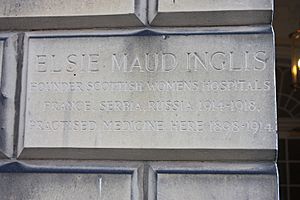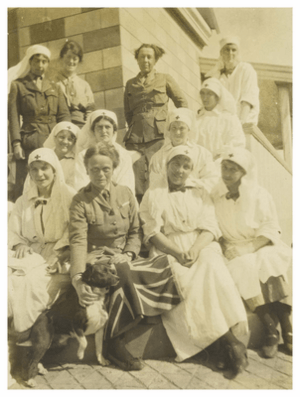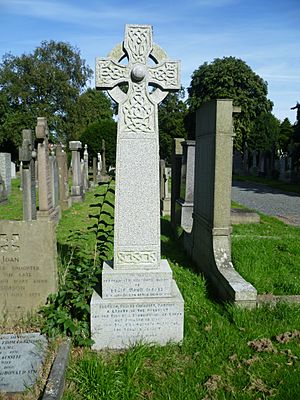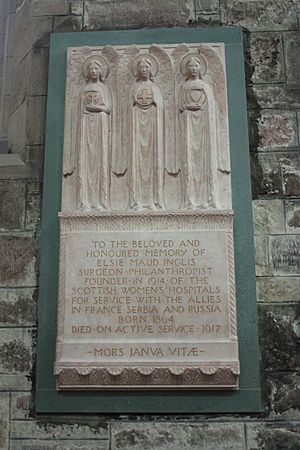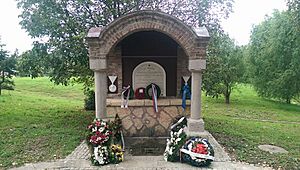Elsie Inglis facts for kids
Quick facts for kids
Elsie Inglis
|
|
|---|---|
 |
|
| Born |
Eliza Maud Inglis (Elsie)
16 August 1864 Naini Tal, India
|
| Died | 26 November 1917 (aged 53) |
| Resting place | Dean cemetery |
| Nationality | British |
| Other names | The Woman with the Torch |
| Alma mater | University of Edinburgh |
| Occupation | Doctor |
| Known for | Suffragist; First World War doctor; campaigner for women and children's health |
| Honours | Serbian Order of the White Eagle (First Class) |

Elsie Maud Inglis (born August 16, 1864 – died November 26, 1917) was an amazing Scottish doctor and surgeon. She was also a teacher and a strong supporter of women's right to vote. Elsie Inglis started the Scottish Women's Hospitals, which were special hospitals run entirely by women. She was also the first woman ever to receive a very important award from Serbia, called the Serbian Order of the White Eagle.
Early Life and Education
Elsie Maud Inglis was born on August 16, 1864, in a town called Naini Tal in India. She had eight brothers and sisters. Her parents, Harriet Lowes Thompson and John Forbes David Inglis, believed that educating girls was just as important as educating boys. Elsie and her sister Eva even had 40 dolls that Elsie pretended to treat for measles!
Elsie's father worked for the government in India. He was a religious man who encouraged local businesses and supported education for girls.
When Elsie's father retired, the family moved back to Edinburgh, Scotland. Elsie went to a private school there and later to a finishing school in Paris. She wanted to study medicine, but she first stayed in Edinburgh to care for her mother, who sadly died in 1885.
In 1887, Elsie began studying at the Edinburgh School of Medicine for Women. However, she and her father soon started their own medical school for women called the Edinburgh College of Medicine for Women. They did this because they disagreed with how the first school was run. This new college helped many women get the medical training they needed.
In 1892, Elsie earned her first medical qualifications. She noticed that women patients often didn't get the best care. So, she worked at a special hospital for women in London and a leading maternity hospital in Dublin. She finally earned her full medical degree from the University of Edinburgh in 1899, after the university started allowing women into its medical courses. Elsie always said she owed everything she achieved to her father.
Medical Career and Helping Others
After finishing her medical degree, Elsie Inglis returned to Edinburgh in 1894. She became a teacher of women's health at the Medical College for Women. She also opened her own medical practice with a friend and fellow student, Jessie MacLaren MacGregor.
Elsie felt that women and children didn't have enough good medical care. So, she and Jessie opened a maternity hospital called The Hospice. This hospital helped poor women and also trained midwives. It started small but grew to include an operating room and beds for patients. This hospital later became the Elsie Inglis Memorial Maternity Hospital. Elsie even traveled to the USA in 1913 to learn about new types of maternity hospitals.
Elsie was very kind to her patients. She often didn't charge them for her services and sometimes even paid for them to recover by the sea. She was especially concerned about childhood illnesses like polio. Other doctors admired Elsie's skills as a surgeon, describing her as "quiet, calm, and collected" and "skilful."
Fighting for Women's Rights
Elsie's concern for women's health also led her to become involved in politics, especially the movement for women's right to vote. In the 1890s, she was the secretary of the Edinburgh National Society for Women's Suffrage. Her father supported her in this work.
Elsie worked closely with Millicent Fawcett, a famous leader of the National Union of Women's Suffrage Societies (NUWSS). Elsie gave speeches all over the country. By 1906, she was a key leader for women's suffrage groups in Scotland, serving as the honorary secretary of the Scottish Federation of Women's Suffrage Societies until 1914.
People described Elsie as "courteous" and "sweet-voiced," but also as someone with a strong will and "fixity of purpose." She was a determined fighter for what she believed in.
World War I Efforts
Even though she was over 50 when the First World War began, Elsie Inglis made a huge impact. She wanted to help the war effort, but the government initially told her to "go home and sit still." Elsie didn't listen!
Instead, she started the Scottish Women's Hospitals for Foreign Service Committee. This organization was funded by the women's suffrage movement. It created hospitals staffed entirely by women, including doctors, nurses, and transport staff. Elsie wanted a neutral name to get support from everyone. She started the fund with £100 of her own money, and soon, with help from Millicent Fawcett, they raised £1,000, aiming for £50,000.
The Scottish Women's Hospitals (SWH) eventually sent 14 teams to countries like Belgium, France, Serbia, and Russia.
The French government was the first to accept Elsie's offer of help. Elsie then led her own unit in Serbia. She was involved in every detail, even choosing the uniform colors. The hospital in France, located at the Abbey of Royaumont, grew from 100 beds to 600 beds to help with the many wounded soldiers from battles like the Battle of the Somme.
Elsie went with the teams to Serbia to improve hygiene and reduce diseases like typhus. Sadly, the typhus outbreak affected the hospital, and four SWH staff members died, including Nurse Louisa Jordan.
In 1915, Elsie was captured by enemy forces in Serbia because she stayed behind to help wounded soldiers. She was later sent back to Scotland in February 1916. But as soon as she arrived, she started organizing funds for another Scottish Women's Hospital team, this time for Russia. She led this team to Odessa, Russia, in August 1916.
Elsie and her team faced many challenges in Russia, including chaos and retreats. She wrote to her sister about the terrible situation, saying, "we are just here in it, and whatever we lose, it is for the right we are standing... The only thing is just to go on doing our bit."
At one point, in a town called Braila, Elsie and just six other doctors treated 11,000 wounded soldiers and sailors. Russian soldiers wrote a letter thanking her for her "tireless and wonderful work."
Elsie, described as an "indomitable little figure," continued her work in Russia for another summer. However, her health was failing due to bowel cancer. She was forced to return to the United Kingdom and sadly died almost immediately upon arrival.
Death and Lasting Legacy
Elsie Inglis died on November 26, 1917, the day after she returned to Britain. Her sisters were with her.
Her body was placed in St Giles Cathedral in Edinburgh, and her funeral on November 29 was a very important event. Both British and Serbian royal family members attended. Many people lined the streets as her coffin was taken to be buried at the Dean Cemetery.
The The Scotsman newspaper called it an "impressive public tribute." Winston Churchill later said that Elsie Inglis and her nurses "will shine in history."
A memorial fountain was built in Elsie's memory in Mladenovac, Serbia, to honor her work there. A plaque also marks her old surgery in Edinburgh. In 1922, a large memorial tablet was placed in St Giles Cathedral in Edinburgh.
Her most important physical memorial was the Elsie Inglis Memorial Maternity Hospital, built in 1925. This hospital helped many women and children in Edinburgh until it closed in 1988. Many Edinburgh children were born there.
In 2009, Elsie Inglis was honored on a new series of banknotes issued by the Clydesdale Bank; her picture appeared on the £50 notes. In 2015, the British Residence in Belgrade, Serbia, was renamed Elsie Inglis House to recognize her work in the country. The President of Serbia, Tomislav Nikolic, said that Elsie Inglis "became a doctor" in Scotland and "a saint" in Serbia.
In 2018, Elsie Inglis's name was included on the base of the statue of Millicent Fawcett in Parliament Square, London, which honors women who fought for suffrage.
Elsie's younger sister, Eva Helen Shaw McLaren, wrote her biography called Elsie Inglis, The Woman With the Torch in 1920. Elsie was described as one of the "greatest-ever" Scottish women and a "great role model."
In November 2021, a plan was launched to create a permanent memorial statue of Elsie Inglis in Edinburgh. By May 2022, a fundraising effort raised £50,000 for the statue. It will be built at the site of her first hospital in Edinburgh. This will be only the third statue of a woman in Edinburgh, compared to forty-three statues of men.
Awards and Honors
In April 1916, Elsie Inglis made history by becoming the first woman to receive the Order of the White Eagle (First class) from Crown Prince Alexander of Serbia. She had also previously received another Serbian award, the Order of Saint Sava.
Images for kids
See also
 In Spanish: Elsie Inglis para niños
In Spanish: Elsie Inglis para niños


